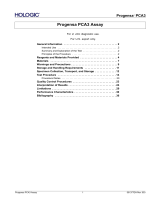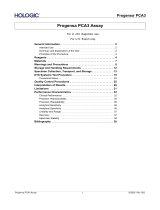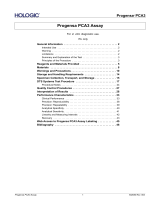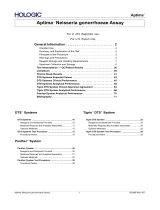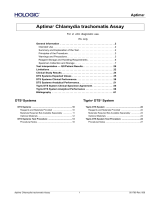Page is loading ...

For Research Use Only. Not for use in diagnostic procedures.
GeneChip™ miRNA 2.0 Assay
Software Module Version 1.0
User Guide

Information in this document is subject to change without notice.
DISCLAIMER
TO THE EXTENT ALLOWED BY LAW, THERMO FISHER SCIENTIFIC AND/OR ITS AFFILIATE(S) WILL NOT BE LIABLE FOR
SPECIAL, INCIDENTAL, INDIRECT, PUNITIVE, MULTIPLE OR CONSEQUENTIAL DAMAGES IN CONNECTION WITH OR
ARISING FROM THIS DOCUMENT, INCLUDING YOUR USE OF IT.
Important Licensing Information
These products may be covered by one or more Limited Use Label Licenses. By use of these products, you accept the terms and
conditions of all applicable Limited Use Label Licenses.
Corporate entity
Life Technologies | Carlsbad, CA 92008 USA | Toll free in USA 1.800.955.6288
Trademarks
All trademarks are the property of Thermo Fisher Scientific and its subsidiaries unless otherwise specified. All other trademarks are the
property of their respective owners.
© 2017 Thermo Fisher Scientific Inc. All rights reserved.
P/N 703073

2 GeneChip™ miRNA 2.0 Assay Software Module Version 1.0
Contents
Chapter 1GeneChipTM miRNA 2.0 Assay Software Module, Version 1.0 .............................. 3
Introduction .............................................................................................................................. 3
Nomenclature ........................................................................................................................................................ 3
Major Features of miRNA 2.0 ASM v1.0 ............................................................................................................. 3
Reagents ................................................................................................................................................................ 3
Installing the Assay Software Module .......................................................................................... 4
Installing a Certificate ........................................................................................................................................... 4
Installing the miRNA 2.0 ASM v1.0 ..................................................................................................................... 5
Creating the Test Request .................................................................................................................................... 12
Adding Additional Information to the Specimen ................................................................................................ 13
The Assay Information Screen—Adding Reagent Information .......................................................................... 15
Batching Additional Test Request Information ................................................................................................... 20
Gridding Manually ................................................................................................................... 22
Transferring Data..................................................................................................................... 23
Reviewing the Test Report ........................................................................................................ 24
Ordering Information ............................................................................................................... 27

GeneChip™ miRNA 2.0 Assay Software Module Version 1.0 3
Chapter 1GeneChipTM miRNA 2.0 Assay Software
Module, Version 1.0
Introduction
This user’s guide shows you how to create the GeneChipTM miRNA 2.0 Assay Software Module v1.0 RUO assay test
request. This module is for the GeneChipTM miRNA 2.0 Assay that is run on the GCS3000Dx v.2 system using the
Molecular Diagnostic Software (AMDS).
This assay software is compatible with the GCS3000Dx v.2 system and the GeneChipTM miRNA 2.0 Array Reagent
Kits.
Nomenclature
The assay name is “GeneChipTM miRNA 2.0 Assay” The assay display name is “miRNA 2.0 ASM v1.0” The term
ASM refers to Assay Software Module.
Major Features of miRNA 2.0 ASM v1.0
The major features of the miRNA 2.0 ASM v1.0 are four screens that augment assay record keeping. This user guide
will also discuss the use of these screens in setting up the assay. These screens include:
1. Additional Information screen
2. Assay Home screen (or Assay Landing screen)
3. Batch Edit screen
4. Report screen
In addition, the miRNA 2.0 ASM v1.0, under the control of the AMDS application, can transfer all specimen
information to the server.
It is not the purpose of this short user’s guide to instruct you on how to run the assay. This user’s guide will show you
how to create the RUO test request. To complete the assay run, you will still need to follow the standard AMDS assay
protocols and process it through the workflow to register, hybridize, wash/ stain, and scan the assay (as part of the
array cartridge). The details of which are discussed in the Molecular Diagnostic Software User Guide (P/N 08-0261).
You must be thoroughly familiar with the information contained in the Molecular Diagnostic Software User Guide,
the Molecular Diagnostic Software Quick Reference Card (P/N 08-0262) and the FlashTag™ Biotin HSR Labeling
Protocol before you can use the information contained in this supplement to run the assay.
Reagents
Reagents for the GeneChipTM miRNA 2.0 Array (single array P/N 901752, 2 arrays P/N 901753, Box of 6 arrays P/N
701754, Box of 30 arrays P/N 901755) comprise the following reagent sub-kits and associated part numbers:
FlashTag™ Biotin HSR RNA Labeling Kit (10 rxn) - P/N: HSR10FTA
FlashTag™ Biotin HSR RNA Labeling Kit (30 rxn) - P/N: HSR30FTA
GeneChipTM Hybridization, Wash, and Stain Kit - P/N: 900720
GeneChipTM Eukaryotic Hybridization Control Kit - P/N: 900454

4 GeneChip™ miRNA 2.0 Assay Software Module Version 1.0
Installing the Assay Software Module
To create a miRNA 2.0 ASM v1.0 test request, you must first install a certificate, second, install the miRNA 2.0 ASM
v1.0, and finally enter the test request.
NOTE: In most cases, a field service technician will install the certificate and assay
software module.
Installing a Certificate
As a security measure, AMDS requires that you or the field service technician install a SSL server certificate on your
local workstation in order for your workstation to communicate with the server. This is required for the transfer of the
miRNA 2.0 ASM v1.0 test request data to the server.
You should have the certificate installed before installing the assay.
The service technician should have installed a certificate at the time of the system’s installation. If for some reason the
service technician did not install a certificate or if the server has changed after the system's initial installation, you
must install or reinstall a certificate.
If a proper certificate has not been installed, you can still install the assay and process test requests; however, you will
have no permission to access the server, and you cannot transfer test request data to the server.
If you cannot access the server and have already installed a certificate, contact Thermo Fisher technical support.
NOTE: You must be logged in with either Laboratory Supervisor or System Maintainer privileges to
install a certificate.
Procedure for Installing a Certificate
The Active Worklist Administrator panel contains the Assay Management button and provides the starting point for
installing a certificate (Figure 1.1).
Figure 1.1 The Active Worklist Administrator Panel (lower left)
1. Click on the Assay Management button. The Assay Management window appears.
2. Click the Install Certificate button. The server certificate browse dialog box appears (Figure 1.2).

GeneChip™ miRNA 2.0 Assay Software Module Version 1.0 5
Figure 1.2 The Server Certificate browse dialog box: note that the CD/DVD drive is the default drive.
3. Select either the default drive, Install from CD (i.e., the internal drive D), or Install from local disk drive.
4. Browse for your desired xxxxx.cer file; where xxxxx is the name of the certificate that the installer of the RUO
server provided to you.
5. Click the OK button or the Cancel button.
6. If successful, you are notified by a message “You have successfully added the server certificate “xxxxx.cer” to the
AMDS trusted certificate store.”
If the certificate installation fails, AMDS notifies you with the particular algorithm error message. The software
prevents you from accessing the server and from transferring data without the proper certificate installed.
7. Click the OK button on the message to return to the Assay Management screen.
Installing the miRNA 2.0 ASM v1.0
The assay installation process is relatively simple. It requires the selection of an assay manifest file and the selection of
approved user access.
NOTE: You must be logged in with either Laboratory Supervisor or with System Maintainer
privileges to install an Assay Software Module.
1. Click on the Assay Management button. The Assay Management window appears.
2. Click the Install Assay button. The Assay Installation browse dialog box appears (Figure 1.3).

6 GeneChip™ miRNA 2.0 Assay Software Module Version 1.0
Figure 1.3 The Assay Installation browse dialog box
3. Click the Browse button. The Assay Installation browse dialog box appears (Figure 1.4).

GeneChip™ miRNA 2.0 Assay Software Module Version 1.0 7
Figure 1.4 The Assay Installation browse dialog box: note this figure shows internal CD drive D:
4. Select either the default drive, Install from CD (i.e., an internal CD drive D), or Install from local disk drive
(i.e., the C: drive).
5. Browse for your desired xxxxx.Manifest file. In the present case, it is the miRNA_2.0_ASM_v1.0.Manifest file.
Typically you will access the manifest file from the D: drive. It should be in the folder similar to D:\\miRNA 2.0
ASM v1.0. Browse for it and select it.
6. Click the OK button. The Assay Installation browse screen appears (Figure 1.5).

8 GeneChip™ miRNA 2.0 Assay Software Module Version 1.0
Figure 1.5 The Assay Installation browse screen for the miRNA 2.0 ASM v1.0
7. Choose those users who will have access to this assay either by selecting individual users, or by clicking the
Select All button, or if you desire to start the selection over, click the Deselect All button.
8. Click the Install button or the Cancel button.
9. If you clicked the Install button, the Data Transfer Server credentials dialog box window appears (Figure 1.6).

GeneChip™ miRNA 2.0 Assay Software Module Version 1.0 9
Figure 1.6 The Data Transfer Server Credentials dialog box
10. Locate and enter the NA Device URL, i.e., the secure URL server where AMDS will send the completed assay
data (as an example: https://dx2webdavserver/RUO).
11. Enter the NA Device Server Username. This is your user name for the server, usually your workstation user
name or network user credentials.
12. Enter the NA Device Server Password. This is your password for the server, usually your workstation user
password or network user credentials.
13. Confirm your password.
NOTE: Your NA Device Server Username and Password are not the user name and
password that you used to log into AMDS. You must enter your user name and password
that you use to access the server.
14. Confirm that the firewall is on and that your workstation is connected to the network.
15. Click the Install button or the Cancel button.
If you clicked Install and if AMDS accepts your user ID and password, the system checks for the appropriate
firewall parameters. The system also checks the proper server credentials, and displays an error message if it
detects the wrong credentials. If the system detects the proper firewall setup, it accepts the assay installation
and returns to the Assay Management screen. Setup is done. You may now begin to use the assay software
module.
16. If the system does not pass your system’s firewall settings, the following error message is displayed (Figure 1.7).

10 GeneChip™ miRNA 2.0 Assay Software Module Version 1.0
Figure 1.7 Error Message
17. Click the Abort button to exit the assay installation procedure.
or click the Retry button to attempt another try.
or click the Ignore button to continue.
IMPORTANT: If you select Ignore, the AMDS will still install the assay, but you will not have
permission to communicate with any remote server.
18. If the same assay already exists in the system, a message appears asking if you would like to repair the assay
(Figure 1.8).
Figure 1.8 The Repair Assay dialog box
Any AMDS user with valid AMDS credentials and with the right permissions can repair, or reinstall, the
assay. You can include a reason, but this is optional.
19. Click the Continue button or the Cancel button. If you clicked Continue, an Assay Installation status window
appears and displays the progress of the assay installation (Figure 1.9).

GeneChip™ miRNA 2.0 Assay Software Module Version 1.0 11
Figure 1.9 The Assay Installation status window
If AMDS detects no errors, it enables the Finish button.
20. Click the Finish button to conclude the assay installation procedure and return to the Assay Management screen.

12 GeneChip™ miRNA 2.0 Assay Software Module Version 1.0
Creating the Test Request
You must be a Laboratory Supervisor, Technician or a Technologist in order to create a test request.
1. If you are not already in the Active Worklist window, select Active Worklist from the Workflow panel on the left
(Figure 1.10). The Active Worklist panel opens.
Figure 1.10 The Active Worklist window
2. Click the Create button on the toolbar of the Active Worklist.
The Enter Test Request Screen appears (Figure 1.11).
Figure 1.11 The Enter Test Request window
3. Enter one or more Specimen ID and Assay Name combinations. The current Assay Name for the GeneChip
miRNA 2.0 ASM v1.0 is miRNA 2.0 ASM v1.0.
4. Once you have made the entries, click the Submit button and the Enter Test Request screen closes. The software
displays the Active Worklist window with the newly created test request(s) on the screen.
NOTE: After you have submitted the test request, the procedures for Registration,
Hybridization, Fluidics Station processing and Scanning are the same as those steps
outlined in the Molecular Diagnostic Software User's Guide (P/N 08-0261). Refer to that
document for further instructions.

GeneChip™ miRNA 2.0 Assay Software Module Version 1.0 13
Adding Additional Information to the Specimen
After you add a specimen, and return to the Active Worklist, you can add certain types of pertinent information about
the specimen. You can also add this information later here, or in other worklists. This information is not necessary in
order to run the assay.
IMPORTANT: You cannot associate any additional information with test requests after
scanning has started. You will not be able to save your edits. If you attempt to save, the
software displays an error message.
Saving and editing specimen information requires an e-signature upon saving.
1. Click on the desired Specimen ID field. The Additional Information dialog box opens (Figure 1.12).
Figure 1.12 The Specimen ID Additional Information dialog box
2. Add the following information. This information includes:
Species - manually entered as freeform text.
Patient ID - manually entered as freeform text or read from a barcode.
Patient Last Name - manually entered as freeform text.

14 GeneChip™ miRNA 2.0 Assay Software Module Version 1.0
Patient First Name - manually entered as freeform text.
Sex-chosen from a drop-down menu. The menu includes the following choices:
Male
Female
Unknown
blank field
Date of Birth - manually entered with defined format. The format must be entered in an ISO 8601 format: that
is with 4-digit year first, then month, then day. (e.g., 2001-11-09 for November 9, 2001) No other format is
allowed.
Specimen Type - chosen from a drop-down menu
Blood
Solid Tissue
Soft Tissue
Saliva
Buccal Swab
Plasma
blank field
Specimen Size Unit - manually entered or from a drop-down menu
mL
μL
oz
mg
g
inch
mm
cm
blank field
Specimen Size Value - manually entered floating-point numeric value.
Method of Collection - manually entered as freeform text
Collection Date - manually entered as an ISO 8601 format date
Collection Time - manually entered using either a 12- or 24-hour time scale. (e.g., 1:15 pm or 13:15). The
software will display the time using 12-hour time scale (e.g., 1:15 pm).
Requestor Last Name - manually entered as freeform text
Requestor First Name - manually entered as freeform text
Requesting Institution - manually entered as freeform text
Request Date - manually entered with defined format manually entered as an ISO 8601 format date
Additional Info 1-5 (Five Additional fields-manually entered as freeform text)

GeneChip™ miRNA 2.0 Assay Software Module Version 1.0 15
3. When you have completed adding the information, click Save and Close or just Close to exit without saving.
When you click Close only, the following events may occur.
If you made no edits, the screen will close.
If you made edits, a pop-up asking Would you like to save changes? (with Yes, No, and Cancel)
appears.
Click Yes in the dialog box and the software collects an e-signature, and then saves and closes the
screen.
Click No and the software discards changes and closes the screen.
Click Cancel and the software returns to the Specimen ID additional information screen with edits
preserved.
The Assay Information Screen—Adding Reagent Information
The Assay Information screen, or the Assay Home screen, provides you with a summary of all the specimen
information, test request logs and pertinent reagent information for particular assay type.
The Assay Home screen has the following tabs/sub-screens:
Reagent Information
Specimen Report
Test Request Log
In any worklist window, in the Assay Name field, click on the Assay Name.
The Assay Home (aka Assay Information) window appears (Figure 1.13). Reagent Information screen is the
default tab.

16 GeneChip™ miRNA 2.0 Assay Software Module Version 1.0
Reagent Information Tab
Click the Reagent Information tab (Figure 1.13) to view current reagent information.
NOTE: If you select specimen IDs from the list on the left, then scan the reagent kit barcode,
the software parses the reagent information and enters the lot number and expiration date
into the correct fields for all selected test requests without manual intervention.
Figure 1.13 The Reagent Information tab
NOTE: Select one or more test requests on the Test Requests list on the left pane. Data is
entered only for the test requests that you have selected.
In the miRNA 2.0 ASM v1.0 (array P/N 901752), you can view the following reagent kit information:
Reagent kit name
FlashTag™ Biotin HSR RNA Labeling Kit (10 rxn)
FlashTag™ Biotin HSR RNA Labeling Kit (30 rxn)
GeneChipTM Hybridization, Wash, and Stain Kit - P/N: 900720
GeneChipTM Eukaryotic Hybridization Control Kit - P/N: 900454
Reagent kit part number information
Reagent kit manufacturer information

GeneChip™ miRNA 2.0 Assay Software Module Version 1.0 17
Reagent lot number
Reagent expiration date
The Reagent Kit Name, Manufacturer, Part Number, Lot No. and Expiration Date are not required to run the assay.
AMDS provides the ability to transfer the Reagent Kit Name, Manufacturer, Part Number, Lot No. and Expiration
Date to the server, along with other test request information.
1. In the Reagent Information tab, select the test requests in the test request list on the left side of the screen. Scan
the barcodes from the reagents you used.
The software will enter the corresponding lot number and expiration date into the appropriate fields. Remember
you cannot make any edits to a test request after the array associated with that particular test request has started
scanning on the GCS3000Dx v.2 scanner.
2. Click the Save button.
3. When you click Close only, the following events may occur.
If you made no edits, the screen will close.
If you made edits, a pop-up Would you like to save changes? with Yes, No, and Cancel buttons appears.
Click Yes in the dialog box and the software saves and closes the screen.
Click No and the software discards the edits and returns to the Reagent Information screen.
Click Cancel and the software returns to the Reagent Information screen with edits preserved.
NOTE: You can also enter the reagent kit information manually by selecting test requests in
the left side of the screen, then placing the cursor in to the lot number and expiration date
fields for the appropriate kits and typing in the correct information.
The miRNA 2.0 ASM v1.0 remembers the association between a reagent kit and expiration date. Scenarios are as
follows:
1. Enter a lot number and expiration date for the first time, click Save.
AMDS saves the data.
2. Enter a lot number already associated with another test request. AMDS auto-populates the expiration date that you
had previously used.
Click Save and the data is saved for all associated test requests.
3. Enter a lot number already associated with another test request. AMDS auto-populates the expiration date that you
had previously used. Modify expiration date and click Save.
The software will display a pop-up with the following message (or words to this effect): “Do you want to
save this expiration date for all other test requests with this lot number?”
Click Yes, No or Cancel.
Yes saves this information for all test requests,
No discards all changes.
Cancel returns to the screen with edits preserved.

18 GeneChip™ miRNA 2.0 Assay Software Module Version 1.0
Special Note Regarding the Changing of Expiration Dates
If you change the expiration date for a previously entered lot number (see step 3 above), and choose to save this
change for all the test requests with this lot number, the application displays the following message:
“You have changed the expiration date for <reagent kit name> Lot <lot number> from <old date> to <new date>.”
“This affects <count> Test Requests.”
The application remembers the new expiration date and updates all the test requests with those lot number(s), which
have not yet started scanning, with the correct expiration date(s).
If you click Cancel, the software returns to the Reagent Information Screen with all edits preserved.
Specimen Report Tab
Click the Specimen Report tab (Figure 1.14) to view all the specimen IDs associated with that assay type (in this case
the GeneChip miRNA 2.0 Assay Software Module v1.0).
Figure 1.14 The Specimen Report tab
Click the Specimen Report tab to view all specimen IDs associated with that assay type. You can view the:
Specimen ID
Patient ID
Patient Last Name
Patient First Name
Requestor Last Name
Requestor First Name
Requesting Institution
Request Date

GeneChip™ miRNA 2.0 Assay Software Module Version 1.0 19
Test Request Log Tab
Click the Test Request Log tab (Figure 1.15) to view all the test requests associated with that assay type. Each test
request will include information regarding the following:
Date (of the log entry)
Time (of the log entry)
User (user logged in when the log entry was created)
Type (of log entry)
Subsystem (associated with log entry)
Short Message (associated with the log entry)
Long Message (related to the selected short message)
Figure 1.15 The Test Request Log tab
/












